
Under the Whyte notation for the classification of steam locomotives, a 2-10-4 locomotive has two leading wheels on one axle, usually in a Bissel truck, ten coupled driving wheels on five axles, and four trailing wheels on two axles, usually in a bogie. These were referred to as the Texas type in most of the United States, the Colorado type on the Burlington Route and the Selkirk type in Canada.
The UIC classification of locomotive axle arrangements, sometimes known as the German classification or German system, describes the wheel arrangement of locomotives, multiple units and trams. It is used in much of the world, notable exceptions being the United Kingdom, which uses the Whyte notation, and in North America, where the AAR wheel arrangement system is used to describe diesel and electric locomotives; Whyte notation is used in North America only for steam locomotives.

In the Whyte notation, a 6-2-0 is a railroad steam locomotive that has an unpowered three-axle leading truck followed by a single powered driving axle. This wheel arrangement is associated with the Crampton locomotive type, and in the USA the single class were sometimes referred to as Cramptons.
Locomotive classification on the Pennsylvania Railroad took several forms. Early on, steam locomotives were given single-letter classes. As the 26 letters were quickly assigned, that scheme was abandoned for a more complex system. This was used for all of the PRR's steam locomotives, and — with the exception of the final type bought — all electric locomotives also used this scheme.
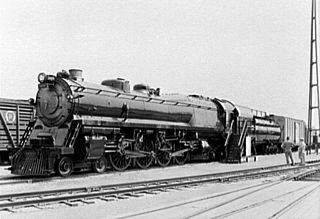
A 4-4-4-4 steam locomotive, in the Whyte notation for describing locomotive wheel arrangements, has a four-wheel leading truck, two sets of four driving wheels, and a four-wheel trailing truck. While it would be possible to make an articulated locomotive of this arrangement, the only 4-4-4-4s ever built were duplex locomotives—with two sets of cylinders driving two sets of driven wheels in one rigid frame, essentially a 4-8-4 with divided drive.

The PRR S1 class steam locomotive was a single experimental duplex locomotive of the Pennsylvania Railroad. It was designed to demonstrate the advantages of duplex drives espoused by Baldwin Chief Engineer Ralph P. Johnson. It was the longest and heaviest rigid frame reciprocating steam locomotive that was ever built. The streamlined Art Deco styled shell of the locomotive was designed by Raymond Loewy.

In Whyte notation, a 4-6-6-4 is a railroad steam locomotive that has four leading wheels followed by six coupled driving wheels, a second set of six driving wheels and four trailing wheels. 4-6-6-4's are commonly known as Challengers.
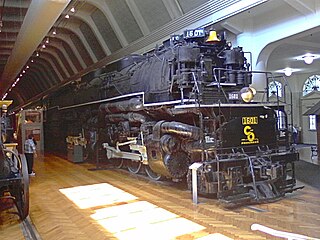
The 2-6-6-6 is an articulated locomotive type with two leading wheels, two sets of six driving wheels and six trailing wheels. Only two classes of the 2-6-6-6 type were built. One was the "Allegheny" class, built by the Lima Locomotive Works. The name comes from the locomotive's first service with the Chesapeake and Ohio Railway beginning in 1941, where it was used to haul loaded coal trains over the Allegheny Mountains. The other was the "Blue Ridge" class for the Virginian Railway. These were some of the most powerful reciprocating steam locomotives ever built, at 7,500 HP, and one of the heaviest at 386 tons for the locomotive itself plus 215 tons for the loaded tender.
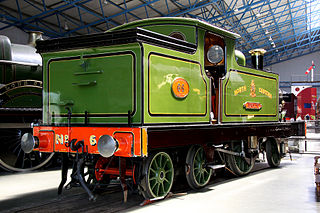
In Whyte notation, a 2-2-4T is a railroad steam locomotive that has two leading wheels followed by two coupled driving wheels and four trailing wheels. This was an unusual wheel arrangement, only used on a few specialised locomotives.
A 4-4-6-4, in the Whyte notation for the classification of steam locomotives by wheel arrangement, is one that has four leading wheels followed by four coupled driving wheels, a second set of six coupled driving wheels and four trailing wheels.
4-14-4, in the Whyte notation classification of steam locomotives by wheel arrangement, is a locomotive with four leading wheels, fourteen coupled driving wheels in a rigid frame, and four trailing wheels.
Under the Whyte notation for the classification of steam locomotives, a 4-8-6 locomotive would have had four leading wheels, eight coupled driving wheels and six trailing wheels.
The Pennsylvania Railroad's class P5 comprised 92 mixed-traffic electric locomotives constructed 1931–1935 by the PRR, Westinghouse and General Electric. Although the original intention was that they work many passenger trains, the success of the GG1 locomotives meant that the P5 class were mostly used on freight. A single survivor, prototype #4700, is at the Museum of Transportation in St Louis, Missouri.

The Pennsylvania Railroad's class O1 comprised eight experimental boxcab electric locomotives built in 1930 and 1931. They were built in preparation for the New York to Washington Electrification project. They had the wheel arrangement classified as 4-4-4 in the Whyte notation. Although successful, they were not powerful enough for the railroad's increasingly heavy trains. For production, the PRR chose to concentrate on the P5 class, effectively an enlarged and more powerful version of the O1 with an additional pair of driving wheels.

The Pennsylvania Railroad's class DD2 electric locomotive was a single prototype locomotive never placed into series production. It was intended as an improved and simplified GG1 for use on the planned, but never built, extension of the PRR's electrification west of Harrisburg, Pennsylvania. The one locomotive produced was numbered #5800 and used in regular Baltimore tunnel helper service until it was scrapped in September 1962.
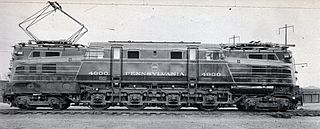
The Pennsylvania Railroad's class R1 comprised a single prototype electric locomotive constructed in 1934 by the Baldwin Locomotive Works of Philadelphia, Pennsylvania, USA, with the electrical equipment by Westinghouse.
The Pennsylvania Railroad class Q1, #6130, was a single experimental steam locomotive designed for dual service. The locomotive entered service in 1942, and retired in 1949 after accumulating a relatively low 165,000 service miles.
Class D14 on the Pennsylvania Railroad was a type of steam locomotive with a 4-4-0 wheel arrangement in the Whyte notation. They were originally designated class P in the PRR's pre-1895 classification scheme. Twenty-two locomotives were built at the PRR's Altoona Works ; six in 1893 with 78-inch (1,981 mm) driving wheels, and sixteen in 1894 with 80-inch (2,032 mm) drivers, classified D14a. Later, all sixteen class D14a were rebuilt to class D14b with 68-inch (1,727 mm) drivers for secondary service after they were replaced in top-flight express service, while three of the six class D14 were similarly rebuilt to class D14c.
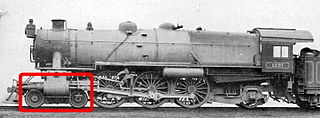
The leading wheel or leading axle or pilot wheel of a steam locomotive is an unpowered wheel or axle located in front of the driving wheels. The axle or axles of the leading wheels are normally located on a leading truck. Leading wheels are used to help the locomotive negotiate curves and to support the front portion of the boiler.
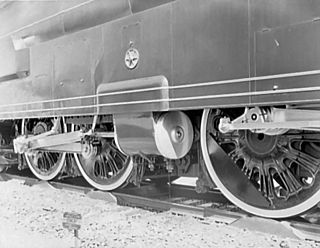
A duplex locomotive is a steam locomotive that divides the driving force on its wheels by using two pairs of cylinders rigidly mounted to a single locomotive frame; it is not an articulated locomotive. The concept was first used in France in 1863, but was particularly developed in the early 1930s by the Baldwin Locomotive Works, the largest commercial builder of steam locomotives in North America, under the supervision of its then chief engineer, Ralph P. Johnson.











